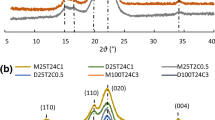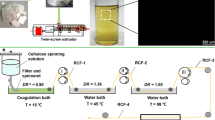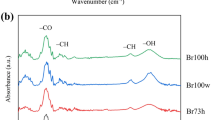Abstract
This work deals with the modifications resulting from the dissolution of four commercial cellulosic samples, with different crystallinity rates and degrees of polymerization (DPs), in four solvent systems, known and used to dissolve cellulose. The dissolution conditions were optimized for the 16 various systems and followed by turbidity measurements. After regeneration, the samples were analyzed by thermal gravimetric analysis (TGA), scanning electron microscopy (SEM), and X-ray diffractometry (XRD) to study their modification. Viscosimetry measurements were used to evaluate the potential decrease of the DP after dissolution. The observed structural modifications established that, for low DP, all the solvent systems were efficient in dissolving the cellulose without altering the DP, except BMIM [Cl], which provoked a decrease of up to 40 % and a decrease of around 20 % of the degradation temperature (onset temperature, T o). For high molecular weight (MW) celluloses, DMSO/TBAF was the only system to allow a complete dissolution without any molar mass loss and degradation temperature modification.



Similar content being viewed by others
References
Zhang S, Li FX, Yu J, Hsieh YL. Dissolution behaviour and solubility of cellulose in NaOH complex solution. Carbohydr Polym. 2010;81:668–74.
Bodvik R, Dedinaite A, Karlson L, Bergström M, Bäverbäck P, Pedersen JS, et al. Aggregation and network formation of aqueous methylcellulose and hydroxypropylmethylcellulose solutions. Colloids Surf A. 2010;354:162–71.
Glasser WG, Atalla RH, Blackwell B, Brown Jr RM, Burchard W, French AD, et al. About the structure of cellulose: debating the Lindman hypothesis. Cellulose. 2012;19:589–98.
Medronho B, Lindman B. Brief overview on cellulose dissolution/regeneration interactions and mechanisms. Adv Colloid Interface Sci. 2015;222:502–8.
Striegel AM. Theory and applications of DMAc/LiCl in the analysis of polysaccharides. Carbohydr Polym. 1997;34:267–74.
Röder T, Morgenstern B, Schelosky N, Glatter O. Solutions of cellulose in N, N-dimethylacetamide/lithium chloride studied by light scattering methods. Polymer. 2001;16:6765–73.
Dupont AL. Cellulose in lithium chloride/N, N-dimethylacetamide, optimisation of a dissolution method using paper substrates and stability of the solutions. Polymer. 2003;44:4117–26.
Jing H, Zhu L, Hua-Yang L, Guo-Hua W, Jun-Wen P. Solubility of wood-cellulose in LiCl/DMAc solvent system. For Stud China. 2007;9:217–20.
Heinze T, Dicke R, Koschella A, Kull AH, Klohr EA, Koch W. Effective preparation of cellulose derivatives in a new simple cellulose solvent. Macromol Chem Phys. 2000;201:627–31.
Östlund Å, Lundberg D, Nordstierna L, Holmberg K, Nydén M. Dissolution and gelation of cellulose in TBAF/DMSO solutions: the roles of fluoride ions and water. Biomacromolecules. 2009;10:2401–7.
Isogai A, Ishizu A, Nakano J. Dissolution mechanism of cellulose in SO2–amine–dimethylsulfoxide. J Appl Polym Sci. 1987;33:1283–90.
Rosenau T, Hofinger A, Potthast A, Kosma P. On the conformation of the cellulose solvent N-methylmorpholine-N-oxide (NMMO) in solution. Polymer. 2003;44:6153–8.
Dogan H, Hilmioglu ND. Dissolution of cellulose with NMMO by microwave heating. Carbohydr Polym. 2009;75:90–4.
Frey M, Cuculo JA, Hinestroza J, Kotek R. Creation of a new class of cellulose engineering materials. National Textile Center Annual Report, M05-CR02. 2006.
Chen X, Chen J, You T, Wang K, Xu F. Effects of polymorphs on dissolution of cellulose in NaOH/urea aqueous solution. Carbohydr Polym. 2015;125:85–91.
Qi H, Liebert T, Meister F, Heinze T. Homogenous carboxymethylation of cellulose in the NaOH/urea aqueous solution. React Funct Polym. 2009;69:779–84.
El Seoud OA, Koschella A, Fidale LC, Dorn S, Heinze T. Applications of ionic liquids in carbohydrate chemistry: a window of opportunities. Biomacromolecules. 2007;8:2629–47.
De Silva R, Vongsanga K, Wang X, Byrne N. Cellulose regeneration in ionic liquids: factors controlling the degree of polymerisation. Cellulose. 2015;22:2845–9.
Boissou F, Mühlbauer A, De Oliveira VK, Leclercq L, Kunz W, Marinkovic S, et al. Transition of cellulose crystalline structure in biodegradable mixtures of renewably-sourced levulinate alkyl ammonium ionic liquids, γ-valerolactone and water. Green Chem. 2014;16:2463–71.
Striegel AM, Timpa JD. Molecular characterization of polysaccharides dissolve in Me2NAc-LiCl by gel-permeation chromatography. Carbohydr Res. 1995;267:271–90.
Sjöholm E, Gustafsson K, Eriksson B, Brown W, Colmsjö A. Aggregation of cellulose in lithium chloride/N,N-dimethylacetamide. Carbohydr Polym. 2000;41:153–61.
Potthast A, Radosta S, Saake B, Lebioda S, Heinze T, Henniges U, et al. Comparison testing of methods for gel permeation chromatography of cellulose: coming closer to a standard protocol. Cellulose. 2015;22:1591–613.
Ciolacu D, Ciolacu F, Popa VI. Amorphous cellulose-structure and characterization. Cell Chem Technol. 2011;45:13–21.
Iguchi M, Aida TM, Watanabe M, Smith RL. Dissolution and recovery of cellulose from 1-butyl-3-methylimidazolium chloride in presence of water. Carbohydr Polym. 2013;92:651–8.
Ramos LA, Frollini E, Heinze T. Carboxymethylation of cellulose in the new solvent dimethyl sulfoxide/tetrabutylammonium fluoride. Carbohydr Polym. 2005;60:259–67.
Swatloski RP, Spear SK, Holbrey JD, Rogers RD. Dissolution of cellose with ionic liquids. J Am Chem Soc. 2002;124:4974–5.
Wendler F, Todi LN, Meister F. Thermostability of imidazolium ionic liquids as direct solvents for cellulose. Thermochim Acta. 2012;528:76–84.
Araki J, Kataoka T, Katsuyama N, Teramoto A, Ito K, Abe K. A preliminary study for fiber spinning of mixed solutions of polyrotaxane and cellulose in a dimethylacetamide/lithium chloride (DMAc/LiCl) solvent system. Polymer. 2006;47:8241–6.
Potthast A, Rosenau T, Sixta H, Kosma P. Degradation of cellulosic materials by heating in DMAc/LiCl. Tetrahedron Lett. 2002;3:7757–9.
Sundberg J, Toriz G, Gatenholm P. Moisture induced plasticity of amorphous cellulose films from ionic liquid. Polymer. 2013;54:6555–60.
Geng H, Yuan Z, Fan Q, Dai X, Zhao Y, Wang Z, et al. Characterisation of cellulose films regenerated from acetone/water coagulants. Carbohydr Polym. 2014;102:438–44.
Park S, Baker JO, Himmel ME, Parilla PA, Johnson DK. Research cellulose crystallinity index: measurement techniques and their impact on interpreting cellulase performance. Biotechnol Biofuels. 2010;3:10.
Nam S, French AD, Condon BD, Concha M. Segal crystallinity index revisited by the simulation of X-ray diffraction patterns of cotton cellulose Iβ and cellulose II. Carbohydr Polym. 2016;135:1–9.
Mangiante G, Alcouffe P, Burdin B, Gaborieau M, Zeno E, Petit-Conil M, et al. Green nondegrading approach to alkyne-functionalized cellulose fibers and biohybrids thereof: synthesis and mapping of the derivatization. Biomacromolecules. 2013;14:254–63.
ASTM D-1795. 2013. Standard test method for intrinsic viscosity of cellulose. AFNOR.
Vaca-Medina G, Jallabert B, Viet D, Peydecastaing J, Rouilly A. Effect of temperature on high pressure cellulose compression. Cellulose. 2013;20:2311–9.
Mazza M, Catana DA, Vaca-Garcia C, Cecutti C. Influence of water on the dissolution of cellulose in selected ionic liquids. Cellulose. 2009;16:207–15.
Li H, Liu D, Wang F. Solubility of dilute SO2 in dimethyl sulfoxide. J Chem Eng Data. 2002;47:772–5.
Potthast A, Rosenau T, Sartori J, Sixta H, Kosma P. Hydrolytic processes and condensation reactions in the cellulose solvent system N, N-dimethylacetamide/lithium chloride. Part 2: degradation of cellulose. Polymer. 2003;44:7–17.
Ciolacu D, Pitol-Filho L, Ciolacu F. Studies concerning the accessibility of different allomorphic forms of cellulose. Cellulose. 2012;19:55–68.
Schmitz S, Dona AC, Castignolles P, Gilbert RG, Gaborieau M. Assessment of the extent of starch dissolution in dimethyl sulfoxide by 1H NMR spectroscopy. Macromol Biosci. 2009;9:506–14.
Kotelnikova NE, Bykhovtsova YV, Mikhailid AM, Saprykina NN. Comparative study on the methods for dissolving powder lignocelluloses in DMAc/LiCl and chemical properties of samples regenerated from the solutions. Russ J Bioorg Chem. 2015;41:700–7.
Markovska I, Lyubchev L. J Therm Anal Calorim. 2007;89:809–14.
Han J, Zhou C, French AD, Han G, Wu Q. Characterization of cellulose II nanoparticles regenerated from 1-butyl-3-methylimidazolium chloride. Carbohydr Polym. 2013;94:773–81.
Kaloustian J, Pauli AM, Pastor J. Analyse thermique de la cellulose et de quelques derives etherifies et esterifies. J Therm Anal Calorim. 1997;48:791–804.
Leroy V, Cancellieri D, Leoni E. Thermal degradation of ligno-cellulosic fuels: DSC and TGA studies. Thermochim Acta. 2006;451:131–8.
Singh S, Varanas P, Singh P, Adams PD, Auer M, Simmons BA. Understanding the impact of ionic liquid pretreatment on cellulose and lignin via thermochemical analysis. Biomass Bioenergy. 2013;54:276–83.
French AD. Idealized powder diffraction patterns for cellulose polymorphs. Cellulose. 2014;21:885–96.
Karimi K, Taherzadeh MJ. A critical review of analytical methods in pretreatment of lignocelluloses: composition, imaging, and crystallinity. Bioresour Technol. 2016;200:1008–18.
Mittal A, Katahira R, Himmel ME, Johnson DK. Effects of alkaline or liquid-ammonia treatment on crystalline cellulose: changes in crystalline structure and effects on enzymatic digestibility. Biotechnol Biofuels. 2011;4:41.
Ahn Y, Song Y, Kwak SY, Kim H. Highly ordered cellulose II crystalline regenerated from cellulose hydrolyzed by 1-butyl-3-methylimidazolium chloride. Carbohydr Polym. 2016;137:321–7.
Karimi K, Taherzadeh MJ. A critical review on analysis in pretreatment of lignocelluloses: degree of polymerization, adsorption/desorption, and accessibility. Bioresour Technol. 2016;203:348–56.
Dupont A, Harrison G. Conformation and d/d determination of cellulose in dimethylacetamide containing lithium chloride. Carbohydr Polym. 2004;58:233–43.
Medronho B, Lindman B. Competing forces during cellulose dissolution: from solvents to mechanisms. Curr Opin Colloid Interface Sci. 2014;19(1):32–40.
Heinze T, Dorn S, Schöbitz M, Liebert T, Köhler S, Meister F. Interactions of ionic liquids with polysaccharides—2: cellulose. Macromol Symp. 2008;262:8–22.
Liebert T, Heinze T. Interaction of ionic liquids with polysaccharides. 5. Solvents and reaction media for the modification of cellulose. Bioresources. 2008;3(2):576–601.
Sen S, Martin JD, Argyropoulos DS. Review of cellulose non-derivatizing solvent interactions with emphasis on activity in inorganic molten salt hydrates. ACS Sustain Chem Eng. 2013;1:858–70.
Dona A, Yuen CW, Peat J, Gilbert RG, Castignolles P, Gaborieau M. A new NMR method for directly monitoring and quantifying the dissolution kinetics of starch in DMSO. Carbohydr Res. 2007;342:2604–10.
Acknowledgments
The authors thank the Advanced Materials Characterisation Facility at Western Sydney University (Australia), Dr. Richard Wuhrer and Dr. Timothy Murphy for the training and assistance in performing XRD and SEM, Matthew Van Leeuwen for discussions about deconvolution of XRD diffractograms, Joel Thevarajah for discussions about polysaccharide dissolution, as well as the NMR facility at the University of New South Wales (Australia), Dr. James Hook and Dr. Aditya Rawal for access to a spectrometer, and Dr. Philippe Evon and Laurent Labonne for the TGA measurements.
Author information
Authors and Affiliations
Corresponding author
Ethics declarations
Conflict of interest
The authors declare that they have no competing interests.
Rights and permissions
About this article
Cite this article
Rebière, J., Heuls, M., Castignolles, P. et al. Structural modifications of cellulose samples after dissolution into various solvent systems. Anal Bioanal Chem 408, 8403–8414 (2016). https://doi.org/10.1007/s00216-016-9958-1
Received:
Revised:
Accepted:
Published:
Issue Date:
DOI: https://doi.org/10.1007/s00216-016-9958-1




